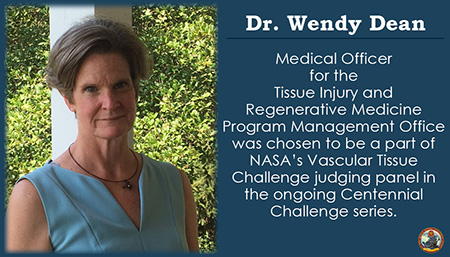USAMMDA's Wendy Dean to Judge NASA's Vascular Tissue Challenge

There are exciting times on the horizon, as the National Aeronautics and Space Administration has recently kicked off its Vascular Tissue Challenge, part of its ongoing Centennial Challenge series, in which multiple research teams will race to successfully grow and harvest 1-centimeter-thick human vascularized organ tissue in an in vitro environment within a controlled laboratory setting. NASA will award a $500,000 prize that will be divided among the first three research teams that can create this metabolically functional tissue before September 30, 2019.
Dr. Wendy Dean, medical officer for the Tissue Injury and Regenerative Medicine Program Management Office of the U.S. Army Medical Materiel Development Activity, was asked to serve on the VTC judging panel, and her enthusiasm is clearly evident when she speaks of this important competition.
"This challenge is a great opportunity for teams to develop human tissue that is substantially thicker than that which researchers have been able to grow and sustain in vitro," said Dean. "The reason it can be sustained is because it contains vascularized channels, which are used to feed the tissue using media or whole blood, or whatever the team chooses to use."
Dean explained that as part of this challenge, tissue thickness remains critical, as there is a limiting factor regarding how dense the matter can be in order to survive.
"This is a tricky task, because every cell in a mass of tissue must be a certain distance from the nutrient source," continued Dean. "In growing tissue, once the mass exceeds a four-cell depth, nutrients cannot reach the center cells, and they eventually die off. This is why the human body contains a massive network of blood vessels all throughout, which makes it truly amazing."
While tissue thickness is a crucial factor in the VTC, additional criteria will be used to determine success and crown the winning teams. The tissue that is created must maintain active blood perfusion (i.e. blood delivered to the cells) and must contain functioning parenchymal cells, which means that the cells must work properly and correctly. For example, liver cells must produce bile; renal tissue must produce urine. Additionally, the teams must show evidence of three successful trials, and each trial must be at least 30 days in length.
Although the impetus for this challenge was to create tissue that may be used to study deep space environmental effects in order to mitigate negative results of travel on humans during long durations in outer space, the potential for other uses is boundless. This aspect truly excites Dean, as she knows what could result from this novel experiment.
"While this contest is certainly forward-looking on NASA's part, the research involved certainly dovetails with the TIRM PMO's mission to restore our wounded warriors, who have been severely injured in combat," said Dean. "This new tissue could potentially be used to treat our Warfighters who lose large amounts of tissue in catastrophic events. We would rather replace this tissue with like matter, whereas now we can only salvage it from some other part of the patient's body, which may open up other issues."
As the sole judge representing the Department of Defense, Dean is part of a tremendous team at USAMMDA that does significant research on a daily basis. As a subordinate command of the U.S. Army Medical Research and Materiel Command, USAMMDA's mission is to develop and deliver quality medical capabilities to protect, treat, and sustain the health of Service Members worldwide. The TIRM PMO team faithfully upholds this task with its highly successful work to help restore catastrophically wounded warriors with form, function and appearance.
And this is why Dean is so intrigued by the VTC Challenge – it really can help save lives.
"I am absolutely excited about seeing the results of this challenge," said Dean, "because I think by letting the teams work on their own, and saying 'go as fast as you can,' it has the potential to reap substantial rewards in terms of progress.
"They're driven by their own passion to succeed," she continued. "No annual reports, no quarterly reports – the judging panel isn't really engaged until a team says that they're finished and are ready to be judged. It's all about racing towards the end, and hoping that the results are successful – which is very different than the traditional funding model."
As a unique part of this challenge, each team must find its own sponsors for research support, as none receives any monetary prize unless it is among the top three winning teams.
Dean is hopeful that this type of research model may help to expand the current knowledge base rapidly, as the information gained may then be used to build success in other areas of tissue regeneration in military and civilian patients.
"The interesting part of having a challenge-type format is that you can potentially uncover technologies that you weren't aware of previously, and you also find out where teams are in their research progress" said Dean. "We may discover that teams are actually farther ahead of what we may have anticipated, and if that's the case, fantastic!
"This type of 'flying start,' like in a sailing race, allows each team the opportunity to enter the field at a different point," continued Dean. "We're asking the teams to prove themselves – to prove their work – before we give them the funds, and this sets the stage for a very productive effort from all involved."
NASA established its Centennial Challenge program in 2005 to encourage public participation in advanced technology development. The unique aspect of these contests is that government funding is not available, and awards are given only to winning teams after the respective challenge is met.
Regardless of the outcome of the NASA VTC, Dean believes one thing is certain: new discoveries will be made, and many of these may eventually reveal effective products and methods that can be used to treat severely wounded Warfighters throughout the world.













